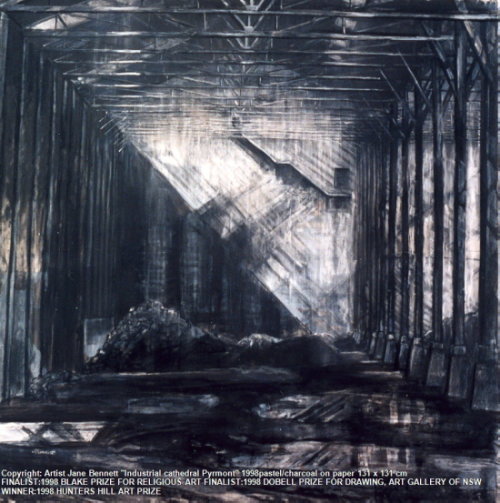The first two paintings on the left hand wall of the room as you enter, were both painted from the roof of the half demolished Pyrmont Power Station a couple of years apart. I was very pleased that I was able to place these together so that viewers can understand the stages of development of this area of Pyrmont.
 |
P103 "From the roof of Pyrmont Power Station"
1994 oil/canvas 92 x 122 cm
|
The rhythmic sweeping lines curving under the bridge are remnants of the old Pyrmont goods line.This was once part of the former Metropolitan Goods Line. There was a goods line from Darling Harbour to Central that had been in existence from about 1856, but a loop line that completed a circuitous route of the inner suburbs became necessary when heavy industry expanded in the early 20th century. Diverging at Dulwich Hill it headed north beneath the Main Suburban line at Summer Hill to Lilyfield before heading east to Rozelle and Pyrmont, and then south under Railway Square through NSW's oldest tunnel to join the Main Suburban line outside Central. This line served the ports at Glebe Island (diverging via a spur from Lilyfield) and Darling Harbour and was approved on 23 November 1914, and the line was finally opened on 23 January 1922. The Darling Island/Darling Harbour section had 19km of track.
The John Street tunnel, a 124m double-track tunnel cut deep into the sandstone under Pyrmont Point, is still in use for the light rail.
During the 1970s and 1980s Darling Harbour traffic reduced considerably and the yards officially closed in October 1984. At vast expense, this goods line was torn up in June 1993 and replaced by the dubious benefit of light rail. Much of the trackbed was used for the light rail that opened to Wentworth Park in August 1997 and extended to Lilyfield in August 2000.
The pile of rubble in the centre marks where an old signal box in the Pyrmont Goods Yard had been just demolished. It was immortalized as the “Spanish café” in Baz Luhrmann's 1992 classic film “Strictly Ballroom”. One person’s eyesore is another’s urban icon.
The brilliant vermilion ship was the “MV Tampa”! It wasn’t notorious then!
The “Tampa” was an early Mark 1 “ConRo” ( roll-on/roll-off container ship) completed in 1984 by Hyundai Heavy Industries Co., Ltd. in South Korea for the Norway based firm, then known as the “Barber Line” and later the “Wallenius Wilhelmsen Line”. It was extensively refurbished and another deck added before it was involved in the controversial event in August 2001 known afterwards as the "Tampa affair".
That wasn't the last scandal involving the MV Tampa.
In October 2006, MV Tampa was one of two Wilhelmsen ships involved in a cocaine-smuggling operation intercepted by the New Zealand Customs Service and the Australian Federal Police. Allegedly 27 kilograms of cocaine had been attached in purpose-built metal pods to the side of the 2 cargo ships bound for Australia. However the New Zealand authorities stated they did not believe the ship's crew or owners were involved.
At the time of this painting Jones Bay Road continued up to the land bridge which then bisected Darling Island and looped around the lower level of Darling Island
All of Jones Bay Road has since been renamed Pirrama Road except for a strange little stub of a street opposite Star Casino. Jones Bay Road used to loop around the whole peninsula, but now the entire street is only about 100 metres long, stretching from the Australian Thermite building ("Darling Island Bond and Free") on the corner at 12 Pyrmont Street, to an apartment block and the 2SM building on the corner of the escarpment.
 |
P214 "Sydney Harbour from the top of the Pyrmont Power Station(building Star Casino)"
1997 oil/board 40 x 89 cm
|
Pier 13 has since been replaced by 'Workplace 6', home of 'Google' and Paul Signorelli's restaurants 'Gastronomia' and 'Biaggio'.
The empty space in the centre of Darling Island has since been filled with offices and apartments, which ironically have been given wharf-like styling. Most of the real wharves had been demolished in the 1980s-1990s.


No comments:
Post a Comment